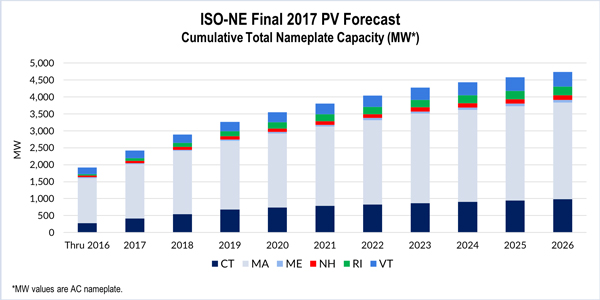By Rich Heidorn Jr.
ISO-NE is asking distribution utilities in the region to adopt interim ride-through requirements for solar PV inverters that it developed with Massachusetts stakeholders, the RTO told its Planning Advisory Committee on Wednesday.
The RTO said it needs to ensure solar PV generation can remain stable during voltage and frequency excursions because of its rapid growth in the region. The RTO’s 2014 forecast predicted about 1,750 MW of solar by 2022. By 2016, however, the RTO had almost 2,000 MW, and the 2017 forecast predicts 4,000 MW by 2022. Massachusetts, home to 60% of the RTO’s solar resources, is expected to double its PV capacity in the next decade.
The new rules are laid out in a source requirement document (SRD) ISO-NE developed with the Massachusetts Technical Standards Review Group, which includes representatives from developers, manufacturers, state regulators and utilities Eversource Energy and National Grid.
The SRD requires that solar inverters have voltage and frequency trip settings and ride-through capabilities and be certified under UL 1741 SA, the safety standard for inverters and interconnection system equipment used in distributed energy resources.
ISO-NE’s David Forrest said the SRD represents an effort to balance transmission and distribution system needs. “Ideally, we’d like DER to ride through any of these faults on the transmission system, [but] … we also have to look at issues on the distribution system,” he said. “So what the ISO is proposing is kind of a compromise between meeting the transmission needs and meeting the distribution needs.”
In Massachusetts, inverter-based solar PV projects greater than 100 kW will be subject to the new rules for interconnection applications submitted on or after March 1. Projects of 100 kW or less will be subject to the rule on June 1.
The RTO hopes utilities in all states will adopt the SRD, saying having one set of requirements for the region will minimize developers’ costs and simplify the modeling of DER in planning studies.
National Grid will require it in Rhode Island, and United Illuminating and National Grid are “looking at implementing the requirements” in Connecticut, Forrest said.
The Energy Policy Act of 2005 requires electric utilities to provide interconnection services based on the Institute of Electrical and Electronics Engineers’ (IEEE) Standard 1547 (Interconnecting Distributed Resources with Electric Power Systems).
ISO-NE said the SRD is “consistent with” Standard 1547 and can be met by all inverters certified under UL 1741 SA. “The key here is that we know that inverters meeting UL 1747 SA are available,” said Forrest.
The RTO sought interim rules while IEEE completes its work on a revised Standard 1547, he said. The institute hopes to complete Standard 1547.1 by late this year or early 2019. Once the revised standard is approved, UL 1741 SA will need to be updated to agree with the revisions, and it will take a year or longer for all inverter manufacturers to have their inverters tested and certified by safety company UL.
As a result, the RTO said it will be 2020 or later before utilities will be able to require use of the revised standard.
The SRD does not cover inverters for fuel cells, traditional generators or energy storage, although they may be covered in the future, Forrest said. “Down the road we may have to look at electric vehicles,” he added. “This isn’t a topic that is going to go away.”




